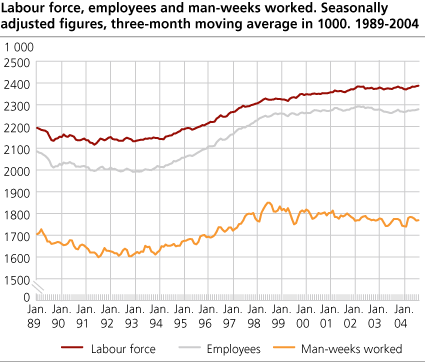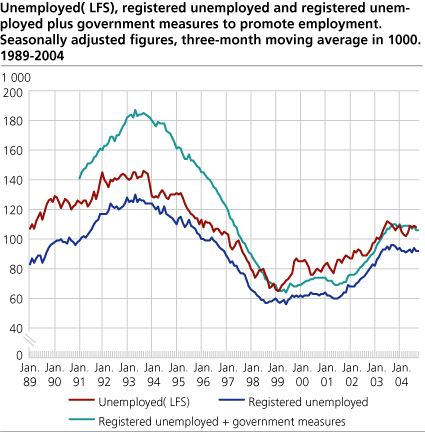Content
Published:
This is an archived release.
More underemployed women
The number of underemployed women increased by 14 000 from the third quarter of last year to the third quarter of 2004, while the figure for men was approximately unchanged. The figures are taken from the latest Labour Force Survey (LFS) carried out by Statistics Norway.
|
Seasonally adjusted figures: Employment on the rise
Unemployment stayed unchanged from Q2 to Q3 2004, and appears to be holding a stable level. In the same period, employment increased by 5 000, which is inside the LFS error margin. Still, employment appears to follow an upward trend, according to seasonally adjusted figures from the LFS. The seasonal adjustment method is a favourable method of revealing the current development in the labour market, and serves as an alternative to comparisons with the corresponding quarter in the previous year. Seasonally adjusted figures are presented in a separate article. |
The total number of underemployed, i.e. part-time employees who want to work more hours, increased from 85 000 to 98 000 from the third quarter of 2003 to the third quarter of 2004. This represents 16.7 per cent of all part-time employees and compares with 14.7 per cent in the third quarter of last year. About 78 per cent of the underemployed were women.
224 000 temporary employed
The number of temporary employees was 224 000 in the third quarter of 2004, approximately on level with the third quarter of last year. Temporary employment was most common in the primary industries, hotels and restaurants, and in health and social work. At the opposite end of the scale, financial intermediation and business activities, transport and communication, and manufacturing are characterised by relatively few temporary employees.
Increase in domestic trade
Employment figures by industry reveal a relatively sharp increase in employment in wholesale and retail trade, and in education, by 13 000 and 9 000 respectively from the third quarter of 2003 to the third quarter of 2004. The manufacturing industry and agriculture experienced a fall in employment in this period.
Slight fall in labour force participation
Total labour force participation fell from 73.4 to 73.2 per cent from the third quarter of 2003 to the third quarter of 2004, and men aged 20-24 were most affected by the decline. Total labour force participation has not been lower since 1996.
Increase in long-term unemployment
The number of unemployed in the third quarter of 2004 was 111 000, approximately unchanged from the third quarter of 2003. The unemployment rate was 4.6 per cent, with 4.8 per cent for men and 4.4 per cent for women. The rate has increased somewhat for women aged 25-54.
The proportion of long-term unemployed increased from 23 to 26 per cent over the past year. Long-term unemployment is defined as unemployment that has lasted for at least six consecutive months.
Actual hours worked for the unemployed and underemployed amounted to 127 000 man-weeks (full-time work) in the third quarter of 2004, an increase of 3 000 from the corresponding quarter of 2003.
Unemployment down in the USA and in Sweden
The seasonally adjusted unemployment rate for Norway was 4.5 per cent in August 2004, compared with 4.6 per cent in May. In the same period, unemployment in the EU and OECD area stayed unchanged at 8.1 and 6.9 per cent respectively. In August, unemployment stood at 5.4 per cent in the USA, down 0.2 percentage points from May. Sweden saw unemployment fall from 6.6 to 6.2 per cent, while unemployment remained unchanged at 9.0 per cent in Finland. In France and Germany unemployment stayed approximately unchanged at 9.6 and 9.9 per cent, according to figures from the OECD and Eurostat .
Tables:
- Table 1. Population aged 16-74 in the labour force, man-weeks worked, registered unemployed persons and persons employed by government measures. 1000 and per cent
- Table 2. Population aged 16-74 år in the labour force, employed persons and unemployed persons by sex (LFS). 1000 and per cent
- Table 3. Persons in the labour force and employed persons by age and sex (LFS). 1 000 and per cent
- Table 4. Population aged 16-74, employed persons by settled/usual working hours per week and unemployed persons by age and sex (LFS). 1000
- Table 5. Persons in the labour force by age and sex. 1000 and as per cent of all in each group
- Table 6. Employed persons by sex and settled/usual working hours pr week (LFS). 1 000
- Table 7. Population aged 16-74 by main activity, part-time employment1 and age (LFS). 1 000
- Table 8. Employed persons by major industry division. 1000
- Table 9. Number of man-hours worked per week1, by industry division (LFS). 1 000
- Table 10. Employed persons,total, and employed persons at work by status and sex. Number of man-weeks worked and actual working hours per week (LFS).
- Table 11. Employed persons and absence from work during the whole survey week by reason for absence and sex. 1000 and per cent
- Table 12. Employees with temporary jobs, by major industry division (LFS). 1000 and as per cent of all employees
- Table 13. Unemployed persons by sex and age (LFS). 1000 and per cent
- Table 14. Unemployed persons by duration of job search (LFS). 1000 and per cent
- Table 15. Unemployed persons by main activity (LFS). 1 000
- Table 16. Unemployed and underemployed persons, by sex and desired working hours per week. Number of man-weeks (of 37,5 hours) supplied (LFS). 1000
- Table 17. Employment and unemployment for persons aged 16-74 years, seasonally adjusted, three-months moving average. Absolute figures in 1000 and unemployed persons in per cent of the labour force.
- Table 18. Persons in the labour force by sex and region (LFS). 1 000 and in per cent of total.
- Table 19. Employed persons by sex and region (LFS). 1 000
- Table 20. Employed persons by sex and regions (LFS) as per cent of all inn each group.
- Table 21 Employed persons, by some major industry division and region (LFS). 1997-2003. 1 000
Contact
-
Arbeidsmarked og lønn
E-mail: arbeidsmarked@ssb.no
-
Erik Herstad Horgen
E-mail: erik.horgen@ssb.no
tel.: (+47) 93 08 68 62
-
Håvard Hungnes Lien
E-mail: havard.lien@ssb.no
tel.: (+47) 40 90 26 06


